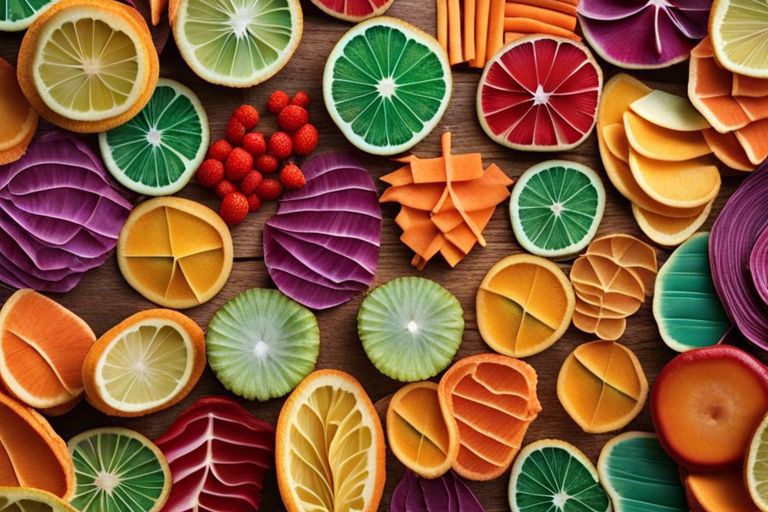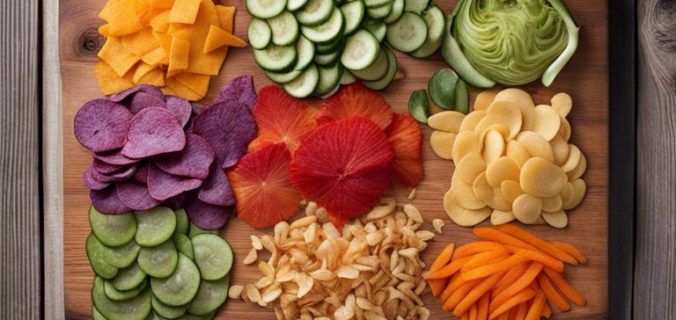Crunchy bites of delight await you in this upcycled vegetable chips recipe. Say goodbye to store-bought snacks full of additives and preservatives, and say hello to a healthier, more sustainable option right from your own kitchen. By giving new life to leftover veggies, you can create a flavor-packed treat that will satisfy your cravings guilt-free. Follow these simple steps to transform ordinary vegetables into extraordinary chips that will have your taste buds singing with joy!

Key Takeaways:
- Nutritious Snack: Upcycled vegetable chips are a nutritious and healthy alternative to traditional potato chips.
- Easy to Make: This recipe is simple and quick to make, requiring just a few basic ingredients and minimal preparation time.
- Sustainable Choice: Using upcycled vegetable scraps helps reduce food waste and contributes to a more sustainable food system.
The Joy of Upcycling
Before we probe the delicious recipe for upcycled vegetable chips, let’s take a moment to appreciate the joy of upcycling. It’s not just about reducing food waste; it’s also about getting creative in the kitchen and discovering new ways to use every part of the vegetables you buy.
Reducing Food Waste
To reduce food waste, you can repurpose vegetable scraps that are usually discarded, like carrot peels, broccoli stems, or kale stems. By upcycling these scraps into tasty chips, you not only minimize waste but also maximize the nutritional value of your ingredients.
Getting Creative with Vegetable Scraps
An exciting aspect of upcycling vegetable scraps is the opportunity to experiment with flavors and seasonings. Carrot peels can be transformed into sweet and savory chips with a sprinkle of cinnamon and a pinch of sea salt, while kale stems can be turned into crispy delights with a drizzle of olive oil and a dash of paprika.
Creative upcycling allows you to tailor the flavors to your preferences, making each batch of vegetable chips a unique and personalized snack.
Choosing the Right Vegetables
While making upcycled vegetable chips, it is imperative to choose the right vegetables that will crisp up perfectly and deliver the best flavors. Here are some guidelines to consider when selecting your produce.
Root Vegetables: Beets, Carrots, and Parsnips
One excellent choice for your homemade chips is root vegetables like beets, carrots, and parsnips. These vegetables offer a natural sweetness and a satisfying crunch when thinly sliced and baked to perfection. Their vibrant colors also make for visually appealing chips that will brighten up any snack time.
Leafy Greens: Kale, Spinach, and More
Vegetables such as kale and spinach can also be transformed into crispy and flavorful chips. Their sturdy leaves hold up well to the baking process, resulting in a light and delicate chip that is packed with nutrients. You can experiment with different seasonings and flavor combinations to create a unique snack that is as nutritious as it is delicious.
Root vegetables like beets will offer a sweet and earthy flavor profile to your chips. Their natural sugars caramelize in the oven, creating a delightful sweetness that pairs perfectly with a sprinkle of sea salt.
Cruciferous Delights: Broccoli, Cauliflower, and Brussels Sprouts
For a more adventurous chip flavor, consider using cruciferous vegetables such as broccoli, cauliflower, and Brussels sprouts. These vegetables have a robust and slightly bitter taste that transforms into a nutty and addictive crunch when baked into chips. They are also high in vitamins and antioxidants, making them a healthy alternative to traditional snacks.
Beets, carrots, and parsnips are excellent choices for making vegetable chips due to their natural sweetness and crunch. These root vegetables can be thinly sliced and baked to crispy perfection, providing a satisfying snack that is both delicious and nutritious.
Preparing Your Vegetables
Washing and Peeling
Many vegetables need to be washed and peeled before being transformed into delicious chips. Washing your vegetables under running water helps remove any dirt or residue. Once clean, use a vegetable peeler to peel off the skin, if desired, which can add a different texture to your chips.
Slicing and Dicing
With a sharp knife, begin by slicing your vegetables into uniform thin slices. Slicing the vegetables thinly ensures that they will crisp up nicely in the oven. To achieve perfectly even cuts, consider using a mandoline slicer.
Dicing the vegetables allows for a different shape and texture to your chips. It can also add variety to your vegetable chip mix, making them visually appealing and fun to eat.
Removing Excess Moisture
Preparing your vegetables for the oven involves removing excess moisture to help them crisp up properly. After you’ve sliced or diced your vegetables, place them on a paper towel or a clean kitchen towel. Patting them dry will help to remove any excess moisture, ensuring your vegetable chips bake evenly and become crunchy.
Peeling your vegetables before removing excess moisture can also help speed up the process, as the skin tends to retain more moisture compared to the flesh.
The Magic of Seasoning
Now, when you’re ready to add some flavor to your homemade veggie chips, look no further than this recipe for Homemade Veggie Chips {Oil Free!} – The Big Man’s World for inspiration.
Salt and Pepper: The Classic Combo
Pepper up your veggie chips with a classic combination of salt and pepper. These two simple seasonings can enhance the natural flavors of the vegetables and add a delicious savory touch to your crunchy snack.
Spicy Delights: Paprika, Garlic Powder, and Chili Powder
Pepper up your veggie chips with a kick by adding paprika, garlic powder, and chili powder to the mix. The combination of these spicy seasonings can take your chips to the next level with a burst of flavor and heat.
Amp up the flavor of your veggie chips with a blend of spices that will leave your taste buds tingling. Paprika adds a smoky depth, garlic powder brings a robust savory note, and chili powder delivers a fiery kick. Combine these seasonings for a zesty and flavorful snack that you won’t be able to get enough of.
Herbal Flavors: Thyme, Rosemary, and Parsley
Parsley up your veggie chips with a touch of herbal goodness by incorporating thyme, rosemary, and parsley into your seasoning mix. These aromatic herbs can add a fresh and earthy flavor to your chips, elevating them to a gourmet level.
Paprika don’t underestimate the power of herbs when it comes to seasoning your veggie chips. Thyme, rosemary, and parsley can bring a whole new dimension of flavor to your snack, making each bite a delightful experience. Sprinkle these herbs generously over your chips before baking for an herbaceous crunch that will have you coming back for more.
Baking to Perfection
Preheating Your Oven
The first step in baking your upcycled vegetable chips to crispy perfection is to preheat your oven. Preheating the oven ensures that your chips cook evenly and become nice and crunchy. Not preheating the oven can result in soggy or unevenly cooked chips.
Single-Layer Baking for Crispiness
The key to achieving perfectly crisp vegetable chips is to ensure they are baked in a single layer on the baking sheet. Single-layer baking allows the heat to circulate evenly around each chip, resulting in a crunchy texture. Placing the chips on top of each other will prevent them from becoming crispy.
Another important tip is to space out your vegetable chips evenly on the baking sheet. If the chips are too close together, they may steam rather than bake, resulting in a softer texture. By spreading them out in a single layer, you ensure that each chip receives consistent heat and becomes deliciously crunchy.
Monitoring Temperature and Time
| Keep the oven temperature at around 375°F for optimal crispiness. | About 15-20 minutes, but check regularly to prevent burning. |
Baking your vegetable chips at the right temperature and for the correct amount of time is crucial for achieving the desired crunchiness. Monitoring the temperature and time throughout the baking process will help you avoid undercooking or burning your chips.
This detailed attention to temperature and time will ensure that your upcycled vegetable chips turn out crunchy, delicious, and perfectly baked every time. By following these baking tips, you will be able to enjoy a healthy and satisfying snack that is not only tasty but also fun to make.
Tips and Variations
All you have to remember is to experiment and have fun while making these upcycled vegetable chips. Here are some tips and variations to help you get creative in the kitchen!
Adding Flavor with Herbs and Spices
Tips: Add a pop of flavor to your vegetable chips by sprinkling them with herbs and spices before baking. Try rosemary and garlic for a savory twist or cinnamon and sugar for a sweet treat. Don’t be afraid to mix and match different seasonings to find your perfect flavor combination.
Experimenting with Different Oils
Different: Pertaining to choosing oils for your upcycled vegetable chips, the possibilities are endless. Experiment with olive oil, coconut oil, avocado oil, or even sesame oil to create unique flavors and textures for your chips. Each oil will give a different taste to your chips, so don’t be afraid to get creative in the kitchen.
Making it a Family Affair: Kids in the Kitchen
Adding: Involving your kids in the process of making upcycled vegetable chips can be a fun and educational experience. You can teach them about healthy eating and cooking skills while bonding over a shared activity. Children are more likely to eat vegetables that they have helped prepare, so this can be a great way to encourage healthy eating habits in your family.
Summing up
Considering all points covered in the article “Crunchy And Delicious – Upcycled Vegetable Chips Recipe”, you now have a detailed guide to creating your own flavorful and sustainable snack. By upcycling leftover vegetables, you not only reduce food waste but also enjoy a tasty treat that is healthier than store-bought chips. Remember to experiment with different seasonings and vegetable combinations to find your favorite flavor profile.
FAQ
Q: Why should I make upcycled vegetable chips?
A: Making upcycled vegetable chips allows you to reduce food waste by using vegetable scraps that you might normally discard. It’s a sustainable way to create a delicious and crunchy snack while promoting environmental consciousness.
Q: What types of vegetables work best for upcycled vegetable chips?
A: Root vegetables like carrot peels, sweet potato skins, and beet scraps are excellent choices for making upcycled vegetable chips. You can also use kale stems or broccoli stalks for a nutritious twist.
Q: How can I store upcycled vegetable chips to keep them fresh?
A: To keep your upcycled vegetable chips crunchy and delicious for longer, store them in an airtight container at room temperature. Adding a silica gel packet or a piece of bread can help absorb excess moisture and maintain their crispness.

